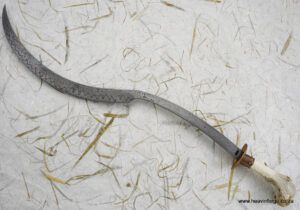October 7, 2024
I Want to Make a Sword!

“I Want to Make a Sword”—How to Encourage Aspiring Bladesmiths
October 7, 2024

“I Want to Make a Sword”—How to Encourage Aspiring Bladesmiths
September 6, 2024
Workshop ergonomics might not seem very important for the part-time bladesmith, but you will still gain interesting tips from this blog post. Ergonomics will evolve with the new tools and equipment you acquire (bladesmiths always need more stuff). Kevin and I have changed the layout of our workshop countless times, and when it comes to moving giant anvils, surface grinders, hydraulic presses, and power hammers, you want to be sure of their positions as you set up your shop. It isn’t easy to move these heavy, semi-permanent machines! Get it right the first time and work around them.
July 2, 2024
Invest in yourself by investing in books. They are the gateway to a universe of knowledge and inspiration.
June 24, 2024
In today’s interconnected world, where knowledge is abundant and innovation thrives, the ABS certification is both a hallmark of tradition and a springboard for further advancement.
June 17, 2024
Choose something that resonates with you. If you’re a blacksmith, bladesmith, or farrier, the rigorous demands of your craft are not to be taken lightly. A tool that’s built to serve, adapt and last is what you need, and this anvil is designed exactly with those needs in mind.
June 17, 2024
The colours of the steel at various temperatures provide an approximate yet reliable indication of its heat, allowing the smith to adjust their technique accordingly.
June 17, 2024
The “critical temperature” is a pivotal point in the forging process. It is the temperature at which the steel’s crystalline structure transforms, indicated by a bright orange glow. Determining this temperature accurately is crucial, as forging above it can cause the steel to become coarse-grained and weak.
June 17, 2024
Crafting a sharp, precise blade demands patience, skill, and the right tools. The journey begins with a belt grinder (if you own one) and transitions to hand sharpening, ensuring that your blade is honed to perfection. This guide will walk you through each step, from the initial grind to the final stropping, providing tips and techniques to achieve a razor-sharp edge. Tapered diamond rods are used to sharpen serrated blades.
June 17, 2024
Heat the test section to critical temperature (the lowest temperature at which the steel loses its magnetism), quench it in oil, place it in a vice, and hammer it as if to break it. If it bends without resistance, it is mild steel; if it resists bending or breaks, it is hardenable.
June 16, 2024
The two primary types of forges are gas forges and coal forges. Each type operates differently and offers distinct advantages and challenges. Understanding these differences is key to selecting the right forge for your needs.